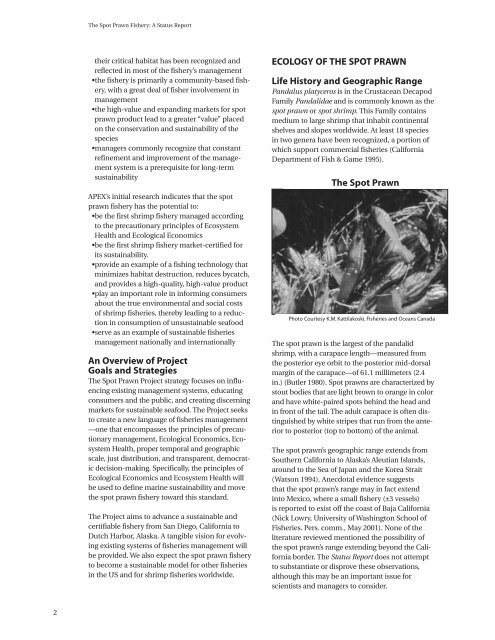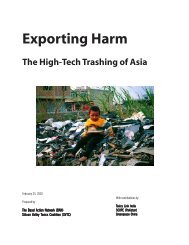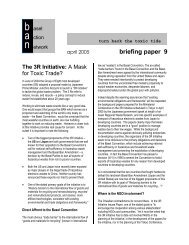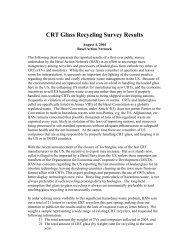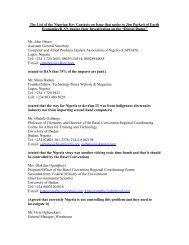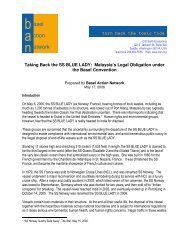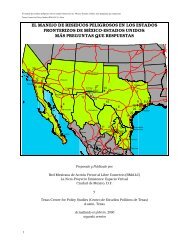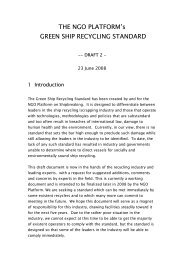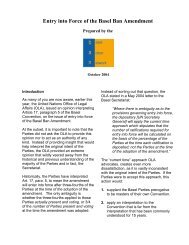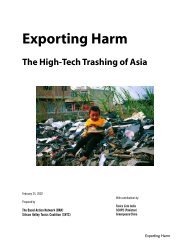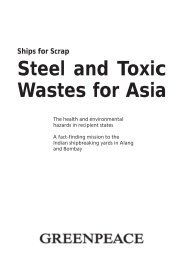The Spot Prawn Fishery The Spot Prawn Fishery - Basel Action ...
The Spot Prawn Fishery The Spot Prawn Fishery - Basel Action ...
The Spot Prawn Fishery The Spot Prawn Fishery - Basel Action ...
You also want an ePaper? Increase the reach of your titles
YUMPU automatically turns print PDFs into web optimized ePapers that Google loves.
2<br />
<strong>The</strong> <strong>Spot</strong> <strong>Prawn</strong> <strong>Fishery</strong>: A Status Report<br />
their critical habitat has been recognized and<br />
reflected in most of the fishery’s management<br />
•the fishery is primarily a community-based fishery,<br />
with a great deal of fisher involvement in<br />
management<br />
•the high-value and expanding markets for spot<br />
prawn product lead to a greater “value” placed<br />
on the conservation and sustainability of the<br />
species<br />
•managers commonly recognize that constant<br />
refinement and improvement of the management<br />
system is a prerequisite for long-term<br />
sustainability<br />
APEX’s initial research indicates that the spot<br />
prawn fishery has the potential to:<br />
•be the first shrimp fishery managed according<br />
to the precautionary principles of Ecosystem<br />
Health and Ecological Economics<br />
•be the first shrimp fishery market-certified for<br />
its sustainability.<br />
•provide an example of a fishing technology that<br />
minimizes habitat destruction, reduces bycatch,<br />
and provides a high-quality, high-value product<br />
•play an important role in informing consumers<br />
about the true environmental and social costs<br />
of shrimp fisheries, thereby leading to a reduction<br />
in consumption of unsustainable seafood<br />
•serve as an example of sustainable fisheries<br />
management nationally and internationally<br />
An Overview of Project<br />
Goals and Strategies<br />
<strong>The</strong> <strong>Spot</strong> <strong>Prawn</strong> Project strategy focuses on influencing<br />
existing management systems, educating<br />
consumers and the public, and creating discerning<br />
markets for sustainable seafood. <strong>The</strong> Project seeks<br />
to create a new language of fisheries management<br />
—one that encompasses the principles of precautionary<br />
management, Ecological Economics, Ecosystem<br />
Health, proper temporal and geographic<br />
scale, just distribution, and transparent, democratic<br />
decision-making. Specifically, the principles of<br />
Ecological Economics and Ecosystem Health will<br />
be used to define marine sustainability and move<br />
the spot prawn fishery toward this standard.<br />
<strong>The</strong> Project aims to advance a sustainable and<br />
certifiable fishery from San Diego, California to<br />
Dutch Harbor, Alaska. A tangible vision for evolving<br />
existing systems of fisheries management will<br />
be provided. We also expect the spot prawn fishery<br />
to become a sustainable model for other fisheries<br />
in the US and for shrimp fisheries worldwide.<br />
ECOLOGY OF THE SPOT PRAWN<br />
Life History and Geographic Range<br />
Pandalus platyceros is in the Crustacean Decapod<br />
Family Pandalidae and is commonly known as the<br />
spot prawn or spot shrimp. This Family contains<br />
medium to large shrimp that inhabit continental<br />
shelves and slopes worldwide. At least 18 species<br />
in two genera have been recognized, a portion of<br />
which support commercial fisheries (California<br />
Department of Fish & Game 1995).<br />
<strong>The</strong> <strong>Spot</strong> <strong>Prawn</strong><br />
Photo Courtesy K.M. Kattilakoski, Fisheries and Oceans Canada<br />
<strong>The</strong> spot prawn is the largest of the pandalid<br />
shrimp, with a carapace length—measured from<br />
the posterior eye orbit to the posterior mid-dorsal<br />
margin of the carapace—of 61.1 millimeters (2.4<br />
in.) (Butler 1980). <strong>Spot</strong> prawns are characterized by<br />
stout bodies that are light brown to orange in color<br />
and have white-paired spots behind the head and<br />
in front of the tail. <strong>The</strong> adult carapace is often distinguished<br />
by white stripes that run from the anterior<br />
to posterior (top to bottom) of the animal.<br />
<strong>The</strong> spot prawn’s geographic range extends from<br />
Southern California to Alaska’s Aleutian Islands,<br />
around to the Sea of Japan and the Korea Strait<br />
(Watson 1994). Anecdotal evidence suggests<br />
that the spot prawn’s range may in fact extend<br />
into Mexico, where a small fishery (±3 vessels)<br />
is reported to exist off the coast of Baja California<br />
(Nick Lowry, University of Washington School of<br />
Fisheries. Pers. comm., May 2001). None of the<br />
literature reviewed mentioned the possibility of<br />
the spot prawn’s range extending beyond the California<br />
border. <strong>The</strong> Status Report does not attempt<br />
to substantiate or disprove these observations,<br />
although this may be an important issue for<br />
scientists and managers to consider.


